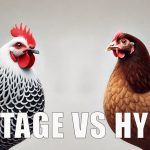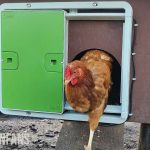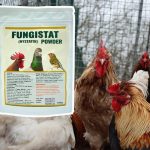Isbar Chicken (Silverudd Blå): Complete Breed Profile

The Isbar chicken, also known as the Silverudd Blå, Swedish Isbar, Svensk Gronaggsvarpare, is a rare Swedish breed created by the known chicken breeder Martin Silverudd. They lay beautiful green eggs, often speckled, ranging in color from dark olive to light moss green.
Let’s find out everything there is to know about this unknown breed.
Let’s start with a few key takeaways:
- Isbar hens lay up to 200 eggs per year
- Swedish pure breed that lays green eggs
- Excellent free rangers that need space
- Cold-hardy
| Eggs | 200 eggs per year |
| Egg Color | Green |
| Egg Size | Large |
| Weight | 6 – 7 lbs |
| Hardiness | Cold |
| Temperament | Active and lively |
| Beginner-friendly | Yes |
| Color | Blue, Splash, and Black |
Characteristics
Isbar chickens are quite large chickens but still medium-sized. They’re not a dual-purpose breed due to their poor meat quality, but excellent egg layers. Their build is slightly shorter than a Rhode Island Red and quite rectangular, but they still look pretty impressive. Roosters weigh between four and seven pounds (2 – 3 kg), and hens tip the scale between three and six pounds (1.3 – 2.7 kg).
The breed can be found in three color varieties, Blue, Splash, and Black, whereas Blue is the most popular, spectacular, and rarest version. In 2016, the Isbar was renamed the Silverudd Blå to prevent confusion and honor its creator.
Blue Isbars range from a light -grey to deeper blue color. They can be in one solid color or Blue with dark patches. Black Isbars have dark ebony or black plumage that shimmers in the light, creating an iridescent effect. Splash Isbar chickens are white in base color with a spotted blue pattern running through their feathering.

The Isbar is the only single-combed, green egg-laying chicken in the world, making them a unique addition to any backyard flock.
The Isbar / Silverudd Blå Breed
To explain how the Silverudd Blå was developed, we need to go back in history to the second half of the 20th century.
About Martin Silverudd
In 1955, Martin Silverudd, a Swedish priest, created some auto-sexing chicken breeds. Living in that day and age, Silverudd didn’t have all the advanced technology and scientific knowledge we have today. However, he was an experienced breeder at the time.
His most famous and popular breed is the 55 Flowery, a rather large millefleur-colored chicken based on a Leghorn. Next to the 55 Flowery, Silverudd created the Smaaland, Queen Silvia, Molilja, and the Isbar. Not all these breeds are widely-known, but his breeding expertise is still praised worldwide.
Developing the Isbar chicken
Silverudd developed the Isbar breed in the second half of the 20th century, but the process was never finished due to the sudden death of its creator in the 1980s. Nor did he keep a log of the breeds’ descriptions and characteristics. But because of the leftover birds of his flock, a breed profile was made, and a group of dedicated breeders was able to save the species.
Isbar Chickens were developed by importing genetic material from Rhode Island Red and New Hampshire. This process created a brand new chicken breed. To include the green egg-laying gene into the Isbar, Silverudd used a Cream Legbar as this English breed owns a blue egg gene. Combined with a brown egg gene of the RIR and New Hampshire, a green egg layer was born!

According to research, Silverudd used an Australorp to create the Blue version of the Isbar chicken, creating a unique bird with lovely blue-grey colored plumage.
The main projective of the Isbar chicken was to create a breed that’s a great egg layer, low in maintenance and does not need much extra care other than food, water, and shelter. And next to this, Silverudd dreamed of creating chicken breeds that lay gorgeously colored eggs that are large in size.
If you want to learn more about egg color genetics, please read our in-depth article, ‘Chicken Egg Color Genetics‘.
Why Call it Silverudd Blå?
In 2016, the name Isbar was no longer used to address the Silverudd Blå breed, and there’s a good reason for that.
First, it is a way of honoring the creator. Silverudd had a ‘working name’ for this breed: Swedish Grönegggsvärpare, meaning green egg layer. But to take over this name would be confusing to any other Swedish green egg layers. The name should refer to the breed created by Silverudd, not referring to any Swedish green egg layer.
Second, when the Isbar became increasingly famous, the name ‘Isbar’ was confusing to many chicken keepers as it refers to ‘barring’ patterns or stripes on the feathers. A distinct feature that a Silverudd Blå did not have.
Third: After carefully re-reading Silverudd’s notes, it became clear that the Isbar chicken was different from the Isbar blue, as all breeds referring to ‘bar’ in their name should be barred or striped. The Isbar also lays green-tinted eggs. To prevent confusion and to prevent the Silverudd Blå being mistakenly mixed with non-Silverudd Blå birds, the two separate breeds were given different names.
But, until today, the heritage breed Silverudd Blå is often referred to as an Isbar chicken. In 2011 the Silverudd Blå was introduced in the US by Green Fire Arms, which still sells day-old chicks to chicken enthusiasts.
Egg Production
Silverudd Blå are decent egg layers, laying around 200 eggs per year. Being cold-hardy birds, hens will keep laying during the winter; however, egg production may slow down.
All eggs are large in size, and true Silverudd Blå birds should always lay green-tinted eggs. The egg may vary from very light green to olive but should never be brown.
Brown eggs in a Silverudd Blå means your bird lacks the dominant blue-egg gene and isn’t correctly and purely bred. This doesn’t mean there’s anything wrong with your bird, but if you’re looking to breed with the Silverudd Blå, you can not have brown egg layers in your flock to ensure the breed’s purity.

Silverudd Blå hens reach sexual maturity around six months of age and will start laying around that time, but this can vary from bird to bird. They aren’t bred to be good sitters; if you’re planning on hatching eggs, you might need an incubator or find another hen to sit on the eggs.
Personality
Silverudd Blå chickens are active and lively birds that love to free-range. They’re fine in confinement but need plenty of space to roam around and scratch their feet in the dirt. It’s best not to keep a Silverudd Blå when only having a small backyard.
They’re friendly and curious but aren’t necessarily pet chickens that can be petted and picked up. If you’re looking for a cuddly chicken, you better look for extremely docile breeds like Silkies or Faverolles.
This breed is exceptionally hardy and adjusts to any weather environment by being more or less active according to their need to save energy. They’re not susceptible to diseases and are an overall healthy breed.
The Silverudd Blå is an excellent asset in your backyard. Not only does this breed has a great look, but they’re wonderful egg layers and friendly chickens. Because of the rareness of the breed, it’s a nice addition to have instead of a Rhode Island Red.
summary
The Silverudd Blå is a fantastic chicken for any poultry keeper with a heart for rare breeds. Not only will you have a unique bird in your flock, but they’re also excellent egg layers, very friendly and hardy birds. These chickens lay up to 200 beautiful green-colored eggs, all large in size.
Having a Silverudd Blå means owning the only single-combed, green egg-laying chicken in the world, a great addition to any flock.
If you want to learn more about chicken breeds that lay colored eggs, check out our article ‘10 Popular Chickens With Colored Eggs‘. Or go to our listicle breed summary on ‘The Classroom‘, or, if you’re unsure where to start, take a look at our ‘Chicken Breeds: Ultimate Beginners Guide‘.
Read more about other Swedish chicken breeds:
55 Flowery: The famous chicken of Martin Silverudd
Hedemora Chicken: The most cold-hardy chicken in the world
Swedish Flower Hen: The beautiful colored backyard bird
Credits Featured Image: @hensonoxney (IG)






















